
Maximizing your B2B eCommerce potential with a CPQ solution

As the B2B market shifts from offline sales to self-service and hybrid selling, a CPQ tool for eCommerce becomes essential. It empowers B2B businesses to meet customer buying expectations and business goals, providing a significant advantage by enhancing revenue efficiency, velocity, and quality. With a CPQ eCommerce solution, businesses can confidently transact online through self-service, partner, or sales-led portals, knowing they are in control of their revenue streams.
This blog will explore how CPQ solutions create an advantage in B2B eCommerce, providing a seamless omnichannel experience that reassures customers and partners, delivers faster time to value, and lowers the risk of data inconsistency.
What is CPQ, and why does it matter for B2B eCommerce?
A CPQ tool ensures the correct product configuration and pricing are always sold to the customer. It helps with:
- Guided selling or buying of the correct product configuration
- Optimally pricing each component
- Quickly obtaining any required approvals
- Offering up-sell or cross-sell suggestions
- Providing an offer for the customer within hours rather than days
- Adhering to negotiated service and pricing agreements
B2B eCommerce solutions provide a richer buying experience by allowing customers and partners to buy at any time through a branded site. There are three core eCommerce channels businesses use to go to market: customer, partner, and direct sales. Customers want a self-serve experience where they can build a cart, reorder, renew, checkout and pay, and request a quote. Partner sellers want to build a cart, reorder or renew on behalf of a customer, order for stock, or present a quote. Internal Sales teams can also use the tool to build a cart, reorder or renew on behalf of a customer, and present a quote.

Having multiple eCommerce channels comes with its challenges:
- Increased costs from managing multiple pricing and product engines across channels
- Inconsistent pricing and configuration rules across channels
- Manual processes required to complete orders through a self-service or partner channel
- Inability to support new revenue streams with inflexible systems
- Inability to support mixed orders (one-time, subscription, usage, etc.) across all channels
With the help of a CPQ eCommerce solution, customers can enjoy a more unified experience across different channels while businesses know the data is accurate. Instead of having multiple platforms with other data sets for these different selling scenarios, a CPQ solution can become the single data source for various platforms, creating a comprehensive B2B digital commerce solution. All channels tie back to the same system with one product master, pricing source, customer master, and rules engine.
Customers will experience a seamless buying experience as channels are connected, allowing them to start an order in one and finish in another. For self-service customers, the tool will enable companies to guide their buying process, suggest configurations, add visualization, and make additional information available so they can make the proper selections.

Streamlining complex product configurations
CPQ software enables businesses to handle complex product configurations easily. Configurators define and manage relationships, rules, and constraints that drive unique components, products, options, and service combinations. When an eCommerce solution is backed with a CPQ configurator, it can guide users through configuring the correct product to address their needs, ensuring accuracy.
Optimizing pricing strategies
CPQ helps manage dynamic pricing models and automates processes for price setting, administration, and execution. It enables efforts to develop, analyze, and update pricing lists, policies, and discounts for different channels. CPQ also considers entitlements, contracted pricing, previous purchases, and more to ensure the right solution is sold at the right price.
The CPQ pricing engine's automation can also handle the definition, launch, and retirement of promotions and rebates. An ecommerce solution powered by a CPQ pricing engine ensures pricing accuracy across multiple selling channels and prevents users from making pricing errors.
Accelerating renewals and reorders
Automated and managed renewal capabilities underpin business models based on subscriptions and recurring revenues. A CPQ provides advanced notice on expirations, while asset-based ordering gives visibility into what has been purchased. A CPQ eCommerce solution ensures you’re not leaving upselling and cross-selling opportunities on the table through recommendations that reference pricing updates, new product introductions, end-of-life schedules, and contract pricing.
3 B2B eCommerce challenges CPQ solves
- Data reliability
One of the biggest wins in B2B commerce is having a single source of truth. A CPQ solution can become the single data source for any selling channel. All channels tie back to the same system with one product master, pricing source, customer master, and rules engine.Some CPQ systems also use the same database as Contract Lifecycle Management (CLM), billing, and order management tools. A unified data platform lowers the risk of data inconsistency between quotes, contracts, and invoices once the order is made.
Solution Selling
Solution selling is the most common strategy for building an all-encompassing offering for B2B customers. This is when multiple products and services are bundled to create an overarching solution. Typical packages may include hardware, software, service, recurring charges, multi-level configurations, and more based on the customer's expanding needs.
While solution selling has many positives, the challenges include:
-Combining subscription-based and one-time products on the same quote. If they cannot be combined, multiple quotes can result in multiple invoices.-Customers don’t have the product knowledge to generate a comprehensive solution in a self-service portal that working with a sales rep could generate.
To help simplify this process, a CPQ solution manages different types of products and services on one quote. Line items like physical products, services, subscriptions, and other quotes that are typically disconnected can all live together within the system. A CPQ tool can also see beyond the current configuration. Product rules ensure specific solution attribute selections or account values are applied to all bundles on the quote, such as design standards, voltage, and country of deployment. One product or service can also be managed with multiple price types to avoid SKU proliferation.
Large orders
Quote sizes are increasing. A business's performance is directly reflected in its ability to handle large quotes, from how fast the quote is created to how accurate it is. For some larger orders, this can include 1,000+ line items, and all line items must be processed for product rules, pricing, and many other attributes.A CPQ tool enables quick configuration, processing, and pricing of large orders with automated pricing rules and numerous configurable attributes. Some tools can process 10,000-line items in one quote, support multiple small bundles, and manage attributes for innumerable products with more variations.
To learn more about the significant changes in B2B commerce, the cost of not addressing these challenges today, and how CPQ solves them, check out our webinar recording on 5 ways CPQ helps enterprises capitalize on B2B commerce changes.
Considerations for implementing CPQ in B2B eCommerce
Integration with existing systems
The CPQ solution must integrate seamlessly with existing systems, such as CRMs and ERPs. A CPQ with an API-first approach ensures the ability to integrate with any CRM or ERP without worrying about ecosystem lock-in. It also allows configuration, pricing, or quoting capabilities to be embedded into eCommerce, direct sales, and partner portals, helping streamline configuration and pricing across the revenue lifecycle.
Revenue Lifecycle Management
Zeroing in on one section of the more extensive process creates tunnel vision. It’s essential to zoom out and look at the other areas of the business that need to be supported, including Contract Lifecycle Management (CLM), Billing, and Document Automation tools and how they interact with an eCommerce strategy. Thinking about the entire revenue lifecycle eliminates the frictions of isolated tech, fragmented data, siloed problem-solving, and poor buyer experiences.
Revenue Lifecycle Management (RLM) sits between a CRM and ERP. While an ERP is designed for the bottom line, and CRM is for the pipeline, RLM is born for the top line. RLM enables seamless process integration and collaboration across the entire revenue lifecycle. It’s imperative to build for the business, not just the process, when implementing a B2B eCommerce strategy.

Assessing your business needs
Think about your business needs before choosing a digital commerce solution. This includes:
- Ensuring a seamless customer experience across all touchpoints
- Allowing customers to move seamlessly between channels; for example, they may request a quote and initiate orders online but complete them with their account executive—or vice versa
- Enabling customers to self-serve if desired—updating account information, checking order status, etc.
- Providing all users—including inside sales and external customers—with the same view of account information, contract terms, and renewals
- Generating accurate invoices and allowing customers to view and pay them online
- Empowering the company to collaborate with business partners and resellers around customer demand and orders
Also, think about the future evolution of your products or business model. For example:
- Changes in go-to-market strategy
- Different products or customer segments
- Moving from physical sales to subscription services
- Shifting from enterprise to SMB customer focus (or vice versa)
- Expanding from domestic to international sales
- Evolving from selling through wholesalers and distributors to selling directly
CPQ for B2B eCommerce
Choose a Digital Commerce solution, including a CPQ, that is agile and flexible and continually adds value to serve your customers, partners, and sellers. Check out our blog on How to evaluate B2B eCommerce software for more details.
CPQ addresses critical challenges like data reliability, solution selling, and managing large orders, making it an indispensable asset for businesses looking to unify their selling channels and provide a seamless, omnichannel experience. Integrating CPQ into your B2B ecommerce strategy can enhance operational efficiency, improve customer satisfaction, and ultimately achieve long-term success.
As you consider the future of your B2B ecommerce operations, think of CPQ not just as a tool but as a strategic investment that will keep your business competitive, agile, and well-positioned to capitalize on the ongoing shifts in the B2B landscape.



